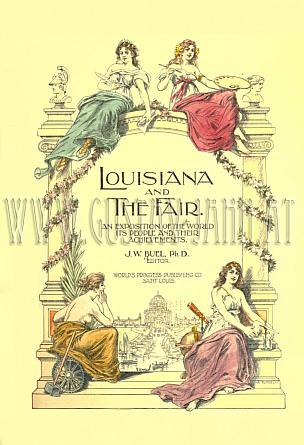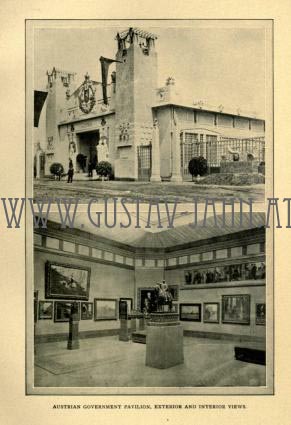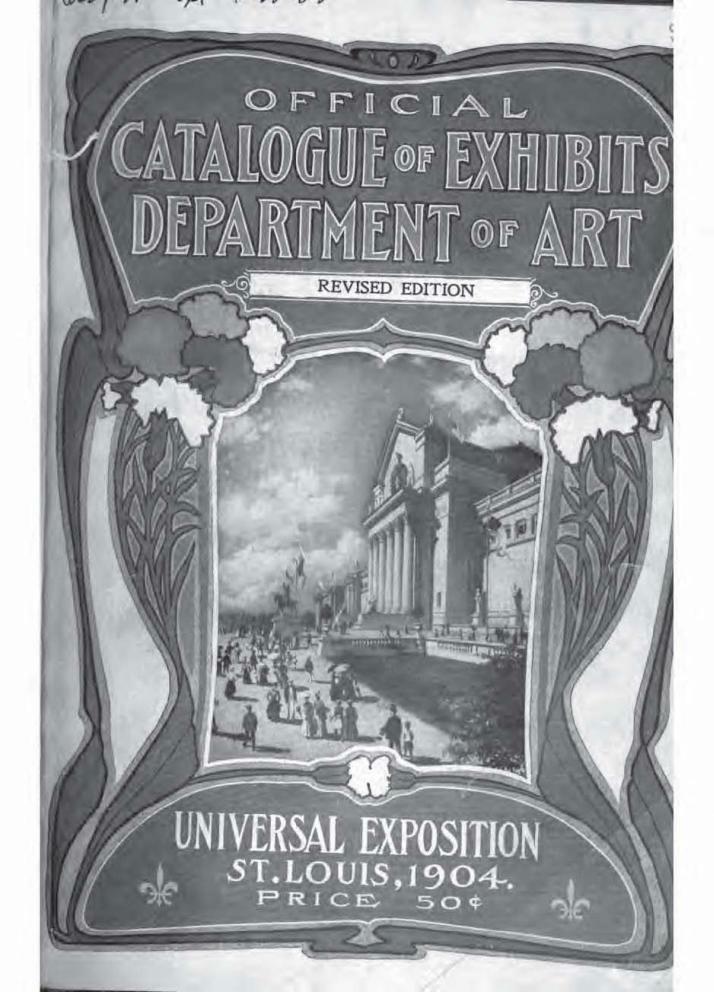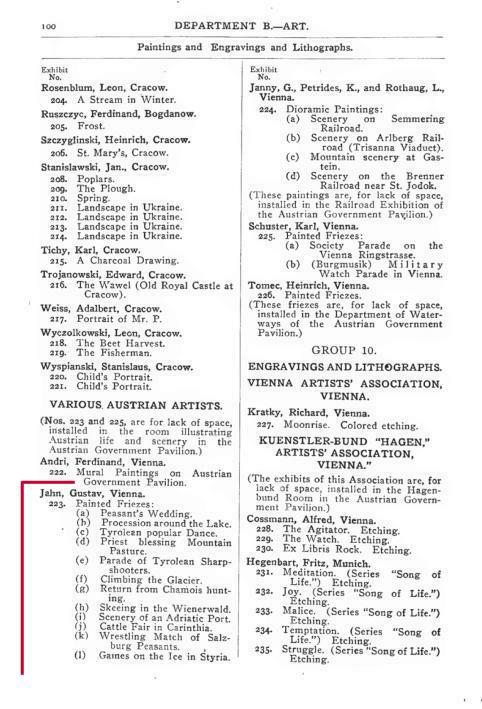GUSTAV JAHN auf der Weltausstellung 1904 in St. Louis
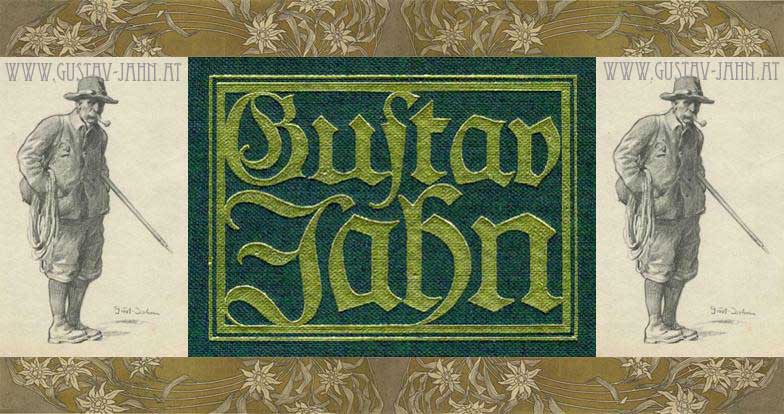
The Louisiana Purchase Exposition - World Fair St. Louis 1904
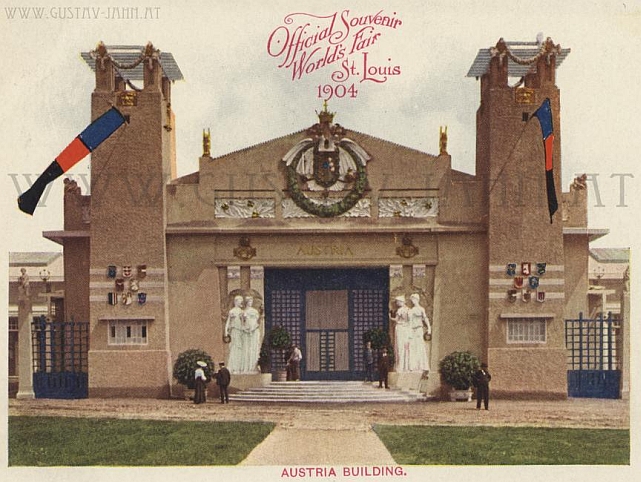 Für die Weltausstellung 1904 in St. Louis gestaltete GUSTAV JAHN im Auftrag der K.K. Staatsbahngesellschaft, eine Reihe von (12) Alpenansichten.
Für die Weltausstellung 1904 in St. Louis gestaltete GUSTAV JAHN im Auftrag der K.K. Staatsbahngesellschaft, eine Reihe von (12) Alpenansichten.
Gezeigt wurden diese im "Austrian Government Building" (Bild links) im Raum "illustrating austrian live and szenery" und er erhielt dafür das Diplom der bronzenen Medaille für Kunst.
Die großflächigen Friesen wurden nach dem Ende der Weltausstellung, im Dezember 1904 nach Wien transferriert und schmückten danach die Ankunftshalle des alten Wiener Westbahnhofes (Kaiserin Elisabeth-Bahnhof). Vermutlich durch Bombenangriffe im II.WK wurden diese vollig zerstört.
Leider ist es uns bis dato noch nicht gelungen, Innenaufnahmen des Westbahnhofes zu bekommen, wo diese Friesen zu sehen sind.
Neben Künstlern des Wiener Hagen Bundes (wie Cossmann Alfred (Vienna), Hegenbart, Fritz (Munich), Lefler, Heinrich, and Urban, Joseph (Vienna), Wesemann, Alfred (Vienna)) u.v.a. , waren auch Werke von Albin Egger Lienz, Ferdinant Andri, Alois Delug und Gustav Jahn in St. Louis vetreten, um für Österreich und seine Schönheiten zu werben.
weitere Künstler:
Adams, John Quincy, Vienna.
Bara, Leopold, Vienna.
Bernt, Rudolf, Vienna.
Brunner, Ferdinand, Vienna.
Czech, Emil, Vienna.
Danilowatz, Joseph, Vienna.
Darnaut, Hugo, Vienna.
Delug, Alois, Vienna.
Egger-Lienz, Albion, Vienna.
Egner, Marie, Vienna.
Fischer, Ludwig Hems, Vienna.
Geller, Johann Nepomuk, Vienna.
Hamza, Johann, Vienna.
Hessl, Gustav H., Vienna.
Jungwirth, Joseph, Kirchberg.
Kaufmann, Adolf, Vienna.
Koch, Ludwig, Vienna.
Kruis, Ferdinand, Vienna.
Larwin, Hans, Vienna.
Lebiedzki, Eduard, Vienna.
Lohwag, Ernestine, Vienna.
Mielich, A. L., Vienna.
Petrovits, Ladislaus Eugen, Vienna.
Pfluegl, Alfred von, Vienna.
Pippich, Karl, Vienna.
Probst, Karl, Vienna.
Ribarz, Rudolf, Vienna.
Russ, Robert, Vienna.
OFFICIAL CATALOGUE OF
EXHIBITORS
Universal Exposition
ST. LOUIS, U.S.A. 1904 .
DIVISION OK EXHIBITS
FREDERICK J. V. SKIFF, Director
Department B,
ART
HALSEY C. IVES, Chief
REVISED EDITION.
PUBLISHED FOR THE COMMITTEE ON PRESS AND PUBLICITY BY
THE OFFICIAL CATALOGUE COMPANY (INC.)
ST. LOUIS, 1904
Ausstellungsverzeichnis Worlds Fair 1904 St.Louis
JAHN Gustav, Vienna - Nr. 223 - Painted Friezes, installed in the room "illustrating austrian live and szenery"
| Abbildung | World Fair Title | ||
|---|---|---|---|
| 1. |  |
Peasant’s Wedding | Bauernhochzeit in Niederösterreich |
| 2. |  |
Procession around the Lake | Fronleichnamsprozession auf dem Traunsee |
| 3. |  |
Tyrolean popular Dance | Beliebter Tiroler Volkstanz |
| 4. |  |
Priest blessing Montain Pasture | Einsegnung einer Alpe in Tirol |
| 5. |  |
Parade of Tyrolean Sharp Shooters | Parade der Tiroler Schützen - Schützenfestzug in Tirol |
| 6. |  |
Climbing the Glacier | Bergsteiger in den Hochalpen |
| 7. |  |
Return from Chamois hunting | Heimkehr von der Gamsjagd |
| 8. |  |
Skeeing in the Wienerwald | Skiläufer im Wienerwald |
| 9. |  |
Scenery of an Adriatic Port | Szene aus dem Hafen von Triest |
| 10. |  |
Cattle Fair in Carinthia | Ein Viehmarkt in Kärnten |
| 11. |  |
Wrestling Match of Salzburg Peasants | Ringkampf von Salzburger Bauern |
| 12. |  |
Games on the Ice in Styria | Eisschiessen in der Steiermark |
Final Report of the Louisiana Purchase Exposition Commission
by
Louisiana Purchase Exposition Commission
Part 6 out of 16
APPENDIX 3.
REPORTS OF FOREIGN COUNTRIES.
AUSTRIA.
_Austrian commission._--Mr. Adalbert R. Von Stibral,
commissioner-general; Mr. Victor Pillwax, assistant commissioner; Mr.
Dominik Fetz, secretary; Mr. Emil S. Fischer, commercial secretary.
_Austrian commercial commission._--Count Johann Harrach, president; Mr.
Oskar Edler Von Hoefft, first vice-president; Mr. Franz Hiess, second
vice-president; Mr. Charles M. Rosenthal, executive commissioner; Mr.
Johann Peterka, commercial director; Mr. Adolph Taussig, commercial
representative and assistant commissioner.
One of the most interesting and, as far as the interior scheme of
decoration is concerned, the most artistic of the various foreign
buildings in the World's Fair grounds, was that of the Austrian Empire.
It was most prominently situated at the western end of Administration
avenue, immediately opposite the Administration Building of the World's
Fair. The garden at the west end of the pavilion, though small,
attracted a great deal of attention on account of its artistic beauty.
Morning-glory and other vines had been planted around the building, and
before the close of the fair had covered the walls and added much to the
beauty of the structure.
 The Austrian Government Building was of impressionistic architecture. It
was 60 meters long, 35 meters wide, and built in the form of a T. From
the transepts a middle aisle, 24 meters broad, extended to the building
line. On either side of the aisle exits led to the loggias and to the
lawns. The pavilion was built of wood and all the rooms had skylights.
The style of architecture and decoration was modern, with a classical
toning. The exterior of the building was faced with a grayish,
yellow-colored gypsum, shaded with gold, dark blue, and light green. Two
groups of figures, above life size, adorned the main porch of the
central building. The imperial coat of arms, with a crown surrounded by
a large wreath, was raised above the center of the pavilion, and to the
The Austrian Government Building was of impressionistic architecture. It
was 60 meters long, 35 meters wide, and built in the form of a T. From
the transepts a middle aisle, 24 meters broad, extended to the building
line. On either side of the aisle exits led to the loggias and to the
lawns. The pavilion was built of wood and all the rooms had skylights.
The style of architecture and decoration was modern, with a classical
toning. The exterior of the building was faced with a grayish,
yellow-colored gypsum, shaded with gold, dark blue, and light green. Two
groups of figures, above life size, adorned the main porch of the
central building. The imperial coat of arms, with a crown surrounded by
a large wreath, was raised above the center of the pavilion, and to the
right and left two sphinxes crowned the gables. The center building
(garden front) was finished with two enormous square pylons, with
festoons and masks and decorated with all the coats of arms of the
Austrian crown lands. Four stela-bearing gilded busts were symmetrically
placed along the front of the flower beds, in which monumental fountains
had been erected. The interior of the building was divided into fifteen
rooms. To the left and right of the entrance hall, which was adorned
with a marble bust of the Emperor, were the official apartments, one of
which was meant as a library and reading room and the other as a
reception room. Beyond the entrance hall was the technical exhibition of
the ministry of railways, which likewise occupied the room on the
left-hand side for an exhibition, "Sceneries and People of Austria." The
hall to the right was devoted to the department of the ministry of
commerce for the building of waterways. At the back part of the middle
aisle a large hall was devoted to the exhibits of the professional art
schools, and two smaller ones showed interiors executed by the schools
for arts and crafts in Vienna and Prague. The fine-arts exhibits of the
Vienna Artists' Association and of the association called "Hagenbund" were on the right of the transepts; pictures by Bohemian and Polish
artists on the opposite side.
The artists and artisans who took part in building and decorating the
Austrian Government pavilion were as follows: The plans of the whole
building, the entrance hall, the two halls of the ministry of railways,
and the hall containing the exhibition of waterways were designed by the
chief architect, Oberbaurat Ludwig Bauman, Josef Meissner substituting
him in the superintendence of the works; contractor J. Lecoeur.
The library was designed by Leopold Bauer, architect, and the architect
Joseph Pleonik designed the reception room.
The plastic on the outside of the building was delivered by the sculptor
Othmar Schimkowitz. The figurate frieze in the library was the work of
the painter Josef Engerhart. The painter Ferdinand Andri executed the
frescoes on the facade and Meinrich Tomec those in the department for
waterways. The Emperor's bust, which was made of Lassar marble and which
had been executed in the workshop of the Tyrol Marble and Porphyry
Company (Fritz Zeller), Laas (Tyrol), was a copy of Professor Strasser's
model.
The relief "Empress Elizabeth" (allegory) in the reception room was by
the late Rudolf Weigl, sculptor.
Sandor Jaray had been intrusted with the interior decorations and
fittings. The carpets were delivered by J. Ginskey, Maffendorf, and the
ornamental locksmith work by Alexander Nehr.
The mosaic and artistic work was done by Max Freiherr von Spann and
Johann Kappner; the fancy needlework by Carl Giani; the inlaid work
(intarsia) by Michael Kehl, Josef Duchoslav, and Franz Makienec, and the
bronze works by Johann Hastach, Carl Kratky, J. Schubert, and A.T.
Lange. On account of the beauty of its furnishings and the harmonious
color schemes of the interior the pavilion was especially attractive to
women visitors to the fair.
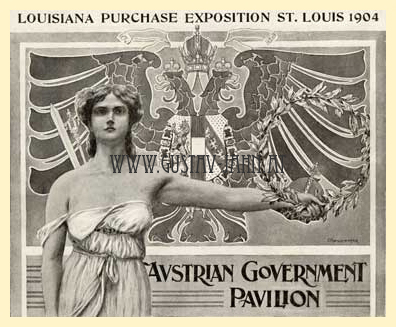 Austria is the home of the European alpine railways. The oldest, the
Semmering Railway, constructed in 1848-1854, lies on the South Railway
main line from Vienna to Trieste and is the first mountain railway
conducted exclusively on the adhesive principle. Then followed the
Brenner Railway (1864-1867), the shortest railway communication between
central Germany via Tyrol to Italy (Verona), and the Arlberg Railway
(1880-1884), which opened up the route via Tyrol and Vorarlberg to the
west (Switzerland and France). Four great panoramas in the exhibition
showing the above-mentioned alpine railways were witness to Austria's
prominence in this special field of railway technique.
Austria is the home of the European alpine railways. The oldest, the
Semmering Railway, constructed in 1848-1854, lies on the South Railway
main line from Vienna to Trieste and is the first mountain railway
conducted exclusively on the adhesive principle. Then followed the
Brenner Railway (1864-1867), the shortest railway communication between
central Germany via Tyrol to Italy (Verona), and the Arlberg Railway
(1880-1884), which opened up the route via Tyrol and Vorarlberg to the
west (Switzerland and France). Four great panoramas in the exhibition
showing the above-mentioned alpine railways were witness to Austria's
prominence in this special field of railway technique.
One room in the pavilion was devoted to the models of alpine railways. There were also plans of the lines, photographic views of buildings and of the tracks of the first three mentioned lines, which are in full working order. The lines in course of construction were further illustrated by models of tunnels, scaffoldings, foundations of arched bridge (with span of 80 meters) over the Isonzo (littoral lands of Austria), with statistical calculations and charts of the largest vaulted bridges ever built, and photographic views of the working in the Karawanken and Wocheiner tunnels.
Among the other exhibits in this department may be mentioned a
model of the groundwork of the Austrian State railways for express
trains, photos of the imperial court train and of the newest locomotives
and passenger carriages of the Austrian State railways, as well as plans
for iron bridges, groundwork, locomotives, and passenger carriages of
the State railways. The work published for the Emperor's jubilee, "History of the Railways of the Austro-Hungarian Monarchy," together
with a number of other publications on the statistics, pedagogy, and
technique of railways, were exhibited. Finally, there was a chart of the
railways of the Austro-Hungarian monarchy on a scale of 1:1000000.
For a long time the Austrian ministry of railways set itself the task of
drawing the attention of the traveling public to the beauties of the
scenery and the ethnographical charms in which Austria abounds, and thus
inducing them to visit the country. To gain this end the ministry issued
various publications, opened inquiry offices, and arranged exhibitions.
The exhibition "Sceneries and People of Austria" in the Government
pavilion was arranged, with the cooperation of several artists, for the
same object. The exhibit principally consisted of a collection of views
of the most beautiful parts of Austria, especially the Austrian Alps,
and pictures of Austrian national life. Photographs taken by the best
photographers, as well as a number of artistic amateur photos,
representing important traveling districts in Austria (99 in all), were
enlarged and reproduced as pigment prints or linographs. Two series of
photographic prints were exhibited also, one consisting of Austrian
castles and strongholds and the other of various favorite alpine
resorts. Further, a selection of alpine and traveling works in luxurious
editions were shown.
The whole exhibition was finished off with a collection of 14 pictures
of costumes and sport, arranged like a frieze and illustrating special
Austrian national scenes. Four bronze statuettes, viz, "Chamois-hunter,"
"Alpine tourist," "Ski sportsman," "Alpine dairy woman," had been placed
in the room as decorations.
The exhibition of models, plans, and photographs of the existing and
projected canal for deep-draft ships, arranged by the department of the
ministry of commerce for the building of waterways, offered a general
view of the whole network of the Austrian waterways, comprising those of
the Danube, Moldau, and Elbe rivers, together with the system of canals.
The beautiful landscape of the river sides was shown by means of views
of the Danube, contained in an album, while the plans, photographs, and
models exhibited by the Danube Regulation Commission showed the river
courses, the harbor in lower Austria and Vienna, as well as the
construction for regulating the water level in the Vienna-Danube Canal.
A map of Prague showed the harbor and canal construction works, some
finished and others projected, in the precincts of the town. The
drawings and photos exhibited in a corner of the hall by the
Aussig-Teplitz Railway Company illustrated the position and traffic of
the harbor of Aussig, the most important inland harbor of Austria. The
charts, in addition to giving a view of the position of the canals and
rivers, with canals projected, showed also longitudinal sections of the
Danube-Oder Canal.
The exhibitions of the State professional art schools, arranged by the
imperial royal ministry of public instruction, Vienna, gave an idea of
the work done by these institutions. The exhibition was arranged in
three divisions, the first two containing the exhibits of the schools
for arts and crafts in Vienna and Prague (the largest of their kind in
Austria) and the third the work of the other professional art schools.
The decoration of the two interiors of the schools for arts and crafts,
Vienna (Director Felizian Freiherr von Myrbach) and Prague (Director
Georg Stibral), as well as all the objects exhibited in these divisions,
were designed at the above institutions and executed by the pupils. The
organization of the "collective exhibition" of the other professional
art schools was intrusted to the inspector of these schools and Hofrat
Arthur von Scala, director of the Austrian Museum, Vienna. The interior
and the exhibits themselves were executed in the workshops of 46
different professional art schools, with the cooperation of the pupils.
The amount of money appropriated by the Austrian Government for the
participation of the Austrian Empire at the exposition was 1,100,000
crowns (about $220,000). The appropriation, however, was almost
exclusively made for the display of Austria in connection with the
Austrian Government Pavilion. The appropriated amount had to cover the
expense for the erection of the pavilion and its installation, as well
as the installation of two rooms in the Fine Arts Building, where the
Vienna Artists' Association had an additional display. The appropriated
amount had also to cover the transportation of the Austrian Government
exhibits as well as the expense of the reshipment of same. The
Government provided the 1,100,000 crowns not only for the erection of
the pavilion and its sculptural works, but for the expenses of
installation, transportation, etc. Part of this money was used by the
various Government participants, viz:
(1) The imperial royal railroad ministry.
(2) The imperial royal department of waterways of Austria.
(3) The imperial royal ministry of education.
(4) And finally by four fine art associations. These fine art
associations were: (1) the Vienna Artists' Association, (2) the
"Hagenbund" Artists' Association of Vienna, (3) the Bohemian artists,
and (4) the Polish Artists.
The fine art associations had their display each in one room of the
thirteen contained in the Austrian Government Pavilion. The Vienna
Artists' Association had also two rooms covering the Austrian section in
the Fine Arts Building.
In reference to the commercial exhibit, a number of prominent
individuals of Austria organized an exhibition of the manufacturers of
Austria. They secured a number of participants, mostly glass and
porcelain manufacturers as well as leather and jewelry merchants of
Austria. Their exhibits representing Austria were displayed in the
Manufactures Building, Varied Industries Building, Liberal Arts
Building, and in the Agricultural Building.

